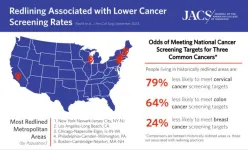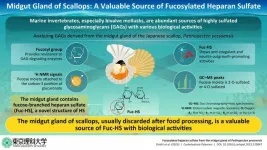(Press-News.org) It’s not easy to distinguish between the dozens of subtypes of limb girdle muscular dystrophy — a rare, genetic muscle disease characterized by weakness in the hips and shoulders that causes difficulty walking and lifting the arms. Until now, determining the subtype has not been critical in caring for patients, because no specific treatments have been available. But gene therapies are on the horizon, and such therapies are targeted to specific genetic variants, so pinpointing the genetic roots of each patient’s disease has taken on a new importance.
In new research, a team at Washington University School of Medicine in St. Louis has developed an approach that could help doctors make more precise diagnoses. The study is published June 15 in The Journal of Clinical Investigation.
Hundreds of genes are associated with limb girdle muscular dystrophy. While genetic testing may identify a handful of rare genetic variants in each patient with the condition, there’s no way to know without painstaking, time-consuming additional experiments which, if any, of those variants is responsible for a patient’s symptoms. Unfortunately, no comprehensive catalog exists yet of all the variants of all the genes linked to limb girdle muscular dystrophy, and whether each of those variants can cause disease or is harmless.
“There are people emailing me all the time saying, ‘I have this variant. Am I eligible for this experimental therapy?’ and much of the time I don’t have an answer,” said co-author Conrad “Chris” Weihl, MD, PhD, a professor of neurology. Weihl is chief of the neuromuscular diseases section and treats people with muscular dystrophy at Barnes-Jewish Hospital. “These patients are in limbo. We can’t get them into clinical trials until they have a diagnosis. More than half of all patients with limb girdle muscular dystrophy are in this position. It’s critical that we resolve their diagnoses so we can get them access to necessary therapies as soon as they become available.”
Weihl and colleagues at Washington University have taken an important step toward creating a catalog that could help resolve inconclusive diagnoses. For one gene commonly involved in the disease, the researchers created the protein that would be made from that gene’s instructions. Then, they made every possible protein variant that could be formed by swapping out one amino acid for another, analyzed the functions of the variants and classified each as harmful or benign. Now, if a patient has a variant of this one gene, doctors can determine its pathogenicity simply by looking up the variant in the catalog. In principle, the same approach could be used to resolve variants of unknown significance for many other genes associated with limb girdle muscular dystrophy, vastly simplifying and speeding up the process of diagnosing this complex disease.
“People conflate knowing that there is a variant with knowing the cause of a disease,” said corresponding author Gabriel Haller, PhD, an assistant professor of neurosurgery. “That isn’t necessarily the case. In this study, most of the variants of unknown significance turned out to be benign. If you find a variant but you don’t know its significance, you haven’t figured out the answer.”
Resolving variants of unknown significance is particularly beneficial to members of underrepresented groups. Genetic databases are dominated by people of western European background and reflect the genetic diversity found in that population. People of other backgrounds are more likely to carry genetic variations that have no match in reference databases and thus get the label “variant of unknown significance.”
For this study, the researchers did a comprehensive analysis of sarcoglycan beta, one of the genes most often linked to limb girdle muscular dystrophy. Sarcoglycan beta forms a complex with three other proteins on the surface of muscle cells. For muscles to contract effectively, the complex must form properly and in the right place on the cell. First author Chengcheng Li, PhD, a staff scientist in Weihl’s lab, created all 6,340 possible variants of sarcoglycan beta protein. Then, she assessed where each variant protein was located on muscle cells, using a fluorescent antibody. Those variants capable of forming the correct complex at the correct spot — in other words, variants with normal functional activity — fluoresced brightly. Those that failed to form the complex properly or were located at the wrong place — i.e., less functional variants — fluoresced more dimly.
The correlation was perfect. All variants known to cause disease scored low in functional activity, while all known benign variants scored high. Not only that, the degree of functional activity correlated with severity of disease. People with the most severe symptoms of limb girdle muscular dystrophy may need to start using wheelchairs as young as age 7, while people with milder symptoms may not need one until decades later, if ever. In the study, variants with lower functional activity more often appeared in patients with more severe symptoms.
“Twenty percent of the variants of unknown significance turned out to be pathogenic, which means they could be amenable to potential therapies,” Weihl said. “My dream is that one day we’ll be able to give people a genetic test report that says, ‘You have this variant, and it’s amenable to this type of therapy,’ and we can start them on the best therapy right away. Or we tell them, ‘Your variant is benign,’ and we keep looking until we find the variant that is responsible for the patient’s disease.”
END
Diagnosis of rare, genetic muscle disease improved by new approach
Accurate diagnosis is a crucial step toward appropriate treatment
2023-06-15
ELSE PRESS RELEASES FROM THIS DATE:
Analysis of race and ethnicity, socioeconomic factors, and tooth decay among children
2023-06-15
About The Study: In this retrospective cohort study, large proportions of disparities in time to first tooth decay associated with race and ethnicity were explained by insurance type and dental procedure types among children and adolescents. These findings can be applied to develop targeted strategies to reduce oral health disparities.
Authors: Sung Eun Choi, S.M., Ph.D., of the Harvard School of Dental Medicine in Boston, is the corresponding author.
To access the embargoed study: Visit our For The Media website at this link https://media.jamanetwork.com/
(doi:10.1001/jamanetworkopen.2023.18425)
Editor’s ...
Prevalence of diabetic retinopathy in the US
2023-06-15
About The Study: In 2021, it is estimated that 9.6 million people in the U.S. (26% of those with diabetes) had diabetic retinopathy and 1.84 million people (5% of those with diabetes) had vision-threatening diabetic retinopathy. There was marked variation in prevalence across states and the number of people living with diabetes-related eye disease grew substantially since prevalence was last estimated in 2004 and may grow in the coming decades due to the increasing burden of diabetes among youth and adults.
Authors: Elizabeth A. Lundeen, Ph.D., of the Centers for Disease Control and Prevention in Atlanta, is the corresponding author.
To access ...
Use of wearable activity trackers to improve patient physical activity, other outcomes in adults who are hospitalized
2023-06-15
About The Study: In this systematic review and meta-analysis of 15 studies and 1,900 participants, interventions that used wearable activity trackers with patients who are hospitalized were associated with higher physical activity levels, less sedentary behavior, and better physical functioning compared with usual care.
Authors: Carol Maher, Ph.D., of the University of South Australia in Adelaide, South Australia, Australia, is the corresponding author.
To access the embargoed study: ...
Shock to the crop system
2023-06-15
As the world faces more climate variability and extremes in the face of global warming, sudden environmental changes add an extra layer of stress to food production in the United States and around the world. It is critical, then, to figure out how the areas in which crops are planted and harvested respond to these stressors, which can bring on ‘shocks’ in production – or, put differently, sudden and statistically significant crop declines.
These production shocks are a big concern in terms of food stability and many crops in the United States—such as corn, cotton, soybeans, and wheat — are all experiencing more frequent production reductions ...
Researchers demystify the unusual origin of the Geminids meteor shower
2023-06-15
The Geminids meteoroids light up the sky as they race past Earth each winter, producing one of the most intense meteor showers in our night sky.
Mysteries surrounding the origin of this meteoroid stream have long fascinated scientists because, while most meteor showers are created when a comet emits a tail of ice and dust, the Geminids stem from an asteroid — a chunk of rock that normally does not produce a tail. Until recently, the Geminids had only been studied from Earth.
Now, Princeton researchers used observations from NASA’s Parker Solar Probe mission to deduce that it was likely a violent, ...
Historic redlining practices cast a long shadow on cancer screening rates
2023-06-15
Key Takeaways
Banned since 1968, the legacy of redlining persists: There continue to be instances of discrimination affecting people in these historically redlined areas.
Redlining was associated with lower odds of hitting screening targets for all three types of cancer: 24% lower odds in breast cancer, 64% lower odds in colorectal, and 79% lower odds in cervical cancer, compared with non-redlined areas.
Actionable initiatives to improve cancer screening rates: Questionnaires to determine barriers to cancer screening, mobile cancer screening ...
Midgut gland of scallops: a valuable source of fucosylated heparan sulfate
2023-06-15
Glycosaminoglycans (GAGs), including chondroitin sulfate (CS), heparan sulfate (HS), heparin, and hyaluronan are linear and acidic polysaccharides found in the extracellular matrix of all animal tissues. GAGs are widely used as functional ingredients in health products, pharmaceuticals, and cosmetics, and are prepared from biological samples such as shark cartilage and porcine intestinal mucosa. Consequently, the demand for new sources of GAGs is ever-present. For example, the supply source of the anticoagulant heparin—generally prepared from porcine intestinal mucosa in China—was threatened by African swine fever in 2018.
GAGs derived from marine invertebrates—animals ...
University of Cincinnati research finds potential therapy for rare but devastating lung disease
2023-06-15
A treatment for a rare cancer-like lung disease found in women of childbearing age may have been discovered by University of Cincinnati researchers.
The rare lung disease is called lymphangioleiomyomatosis or LAM, and the cause of it is unknown with no cure established. New UC research, funded by the National Heart, Lung, and Blood Institute, discovered that two existing drugs show signs of being effective in treating LAM and could lead to the development of a cure.
The study was published in Science Advances,
“The exact number of women with LAM is unknown but it is estimated that for every 1 million women in the world, three to seven ...
Insilico Medicine’s transformer-based aging clock provides insights into aging, disease, and new therapeutic targets
2023-06-15
Clinical stage generative artificial intelligence (AI)-driven drug discovery company Insilico Medicine (“Insilico”) has announced a new multimodal transformer-based aging clock that is capable of processing diverse data sets and providing insights into biomarkers for aging, mapping them to genes relevant to both aging and disease, and discovering new therapeutic targets designed to slow or reverse both aging and aging-related diseases. The company calls the aging clock Precious1GPT, in a nod to the powerful “One Ring” in Lord of the Rings. The findings were published in the June 13 issue of the journal Aging.
Insilico has been ...
Hip fracture burden to nearly double worldwide by 2050
2023-06-15
An international group of researchers led by the Department of Pharmacology and Pharmacy, LKS Faculty of Medicine, the University of Hong Kong (HKUMed), and including Douglas P Kiel, MD, MPH, Director Musculoskeletal Research Center, Marcus Institute for Aging Research, Hebrew SeniorLife, and Professor of Medicine, Harvard Medical School, evaluated the secular trends in hip fracture incidence, treatment patterns following a hip fracture, and all-cause mortality in 19 countries and regions from 2005 to 2018. While the age- and sex-standardised hip fracture incidence rates decreased ...
LAST 30 PRESS RELEASES:
Eye for trouble: Automated counting for chromosome issues under the microscope
The vast majority of US rivers lack any protections from human activities, new research finds
Ultrasound-responsive in situ antigen "nanocatchers" open a new paradigm for personalized tumor immunotherapy
Environmental “superbugs” in our rivers and soils: new one health review warns of growing antimicrobial resistance crisis
Triple threat in greenhouse farming: how heavy metals, microplastics, and antibiotic resistance genes unite to challenge sustainable food production
Earthworms turn manure into a powerful tool against antibiotic resistance
AI turns water into an early warning network for hidden biological pollutants
Hidden hotspots on “green” plastics: biodegradable and conventional plastics shape very different antibiotic resistance risks in river microbiomes
Engineered biochar enzyme system clears toxic phenolic acids and restores pepper seed germination in continuous cropping soils
Retail therapy fail? Online shopping linked to stress, says study
How well-meaning allies can increase stress for marginalized people
Commercially viable biomanufacturing: designer yeast turns sugar into lucrative chemical 3-HP
Control valve discovered in gut’s plumbing system
George Mason University leads phase 2 clinical trial for pill to help maintain weight loss after GLP-1s
Hop to it: research from Shedd Aquarium tracks conch movement to set new conservation guidance
Weight loss drugs and bariatric surgery improve the body’s fat ‘balance:’ study
The Age of Fishes began with mass death
TB harnesses part of immune defense system to cause infection
Important new source of oxidation in the atmosphere found
A tug-of-war explains a decades-old question about how bacteria swim
Strengthened immune defense against cancer
Engineering the development of the pancreas
The Journal of Nuclear Medicine ahead-of-print tip sheet: Jan. 9, 2026
Mount Sinai researchers help create largest immune cell atlas of bone marrow in multiple myeloma patients
Why it is so hard to get started on an unpleasant task: Scientists identify a “motivation brake”
Body composition changes after bariatric surgery or treatment with GLP-1 receptor agonists
Targeted regulation of abortion providers laws and pregnancies conceived through fertility treatment
Press registration is now open for the 2026 ACMG Annual Clinical Genetics Meeting
Understanding sex-based differences and the role of bone morphogenetic protein signaling in Alzheimer’s disease
Breakthrough in thin-film electrolytes pushes solid oxide fuel cells forward
[Press-News.org] Diagnosis of rare, genetic muscle disease improved by new approachAccurate diagnosis is a crucial step toward appropriate treatment




